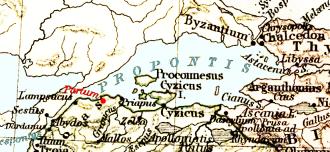 |
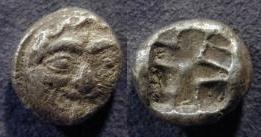 |
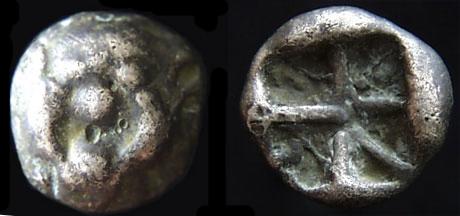 |
I've never seen another example of this reverse type, a quadripartite incuse square with each square bisected. At 3.83g this is the heaviest example in my collection. It has the globular eyes, simple nose and pit-like mouth I've only seen with the irregular square type. Unpublished? Readers who have seen this reverse type, in catalogs or private collections, please contact me. Oddly, a similar incuse square is present on an electrum Phokaian coin published as BMC Ionia Phocaea 3. The obverse of the Phokaian coin is a facing head described as Silenos. |
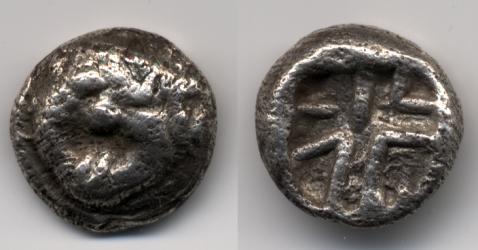 |
This is the "irregular incuse square" reverse. (This example is a little more regular than is typical for the irregular reverse.) The examples I've seen have globular eyes and tend to be heavy, this example is 3.52g. |
  |
This and the next are the most common type. The
face is somewhat clown-like. The eyes are almond-shaped and the nose
looks like a nose. The reverse always has a pellet in the center although they can be quite weak. I'm not clear why it was so weak, perhaps the dies were heavily worn? The first example is 3.1g and the second 3.0g. Nice examples of this type command a heavy premium in the market, but typical ones can be very inexpensive. |
 |
This example is much lighter than the others at
only 2.1g. The nose is also highly unusual. There is a sort of
"cartoon 2D nose" effect. I suspect this is an ancient imitation. This picture makes the coin look nicer than it is. The actual coin is quite worn. |
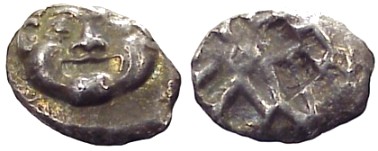 |
This coin is in very high relief and the reverse
is double struck. (Or perhaps overstruck?) The style is quite different from other examples
I've seen of the archaic type. It looks like a high-relief version
of the gorgon/bull design. 3.2g. The reverse of this coin is double-struck, or perhaps overstruck on another example. |

|
This is a fourreé, an ancient counterfeit. It is made of bronze and silver-plated. 2.28g. |
 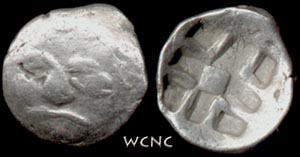 |
This was sold as a "Celtic imitation" of Parion
This coin and the next two have a thin, cupped flans. Dewing 2349 is an example of this coin. The Dewing catalogers for this region, Ursula Pause-Dreyer and Silvia Hurter, attribute it to an uncertain mint in Western Asia Minor. Dewing's example has a pellet in the center and masses 1.76g. An example without the pellet is SNG Deutschland Leipzig 1085, attributed to Parion and massing 1.73g. Another published example is item 8 in table 13 of Robert Forrer's Keltische Numismatik 2. The coin is apparently attributed to the 'Tectosages of Galatia' tribe. (I don't have the volume.) The first example has a rather vicious flan crack and weighs 2.2g. The second example has a well defined square rather than a pellet at the center. 1.6g. |
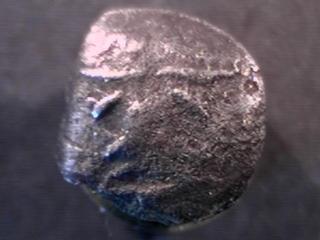 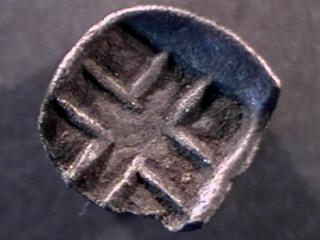 |
This example masses only 0.89g. I believe it to be a half-unit of the above two and perhaps unpublished. Seen anything like this? I'd like to compare this with other examples, if any. |
 |
I believe this to be an unpublished lead token of the above. Please, if you have anything similar, contact the author. |
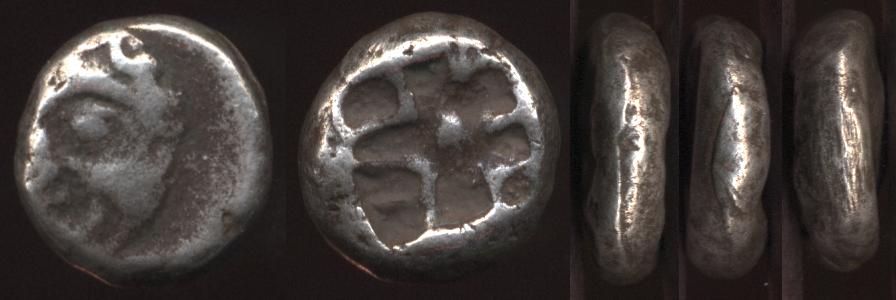 |
MODERN CAST COUNTERFEIT. See Cast Greek AR for more details. |
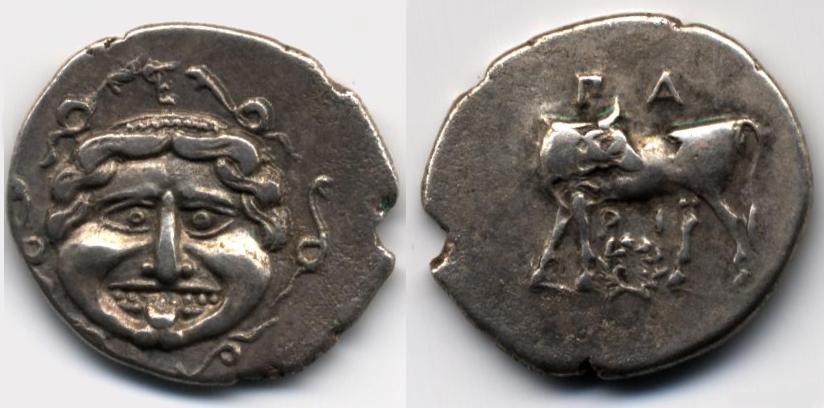
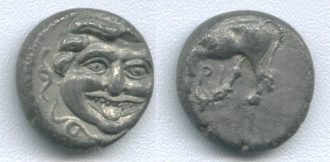
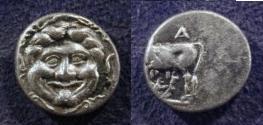
 |
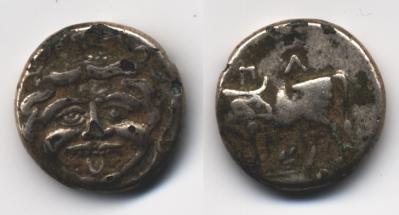
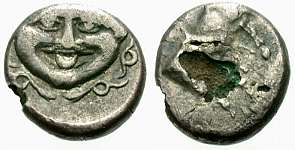
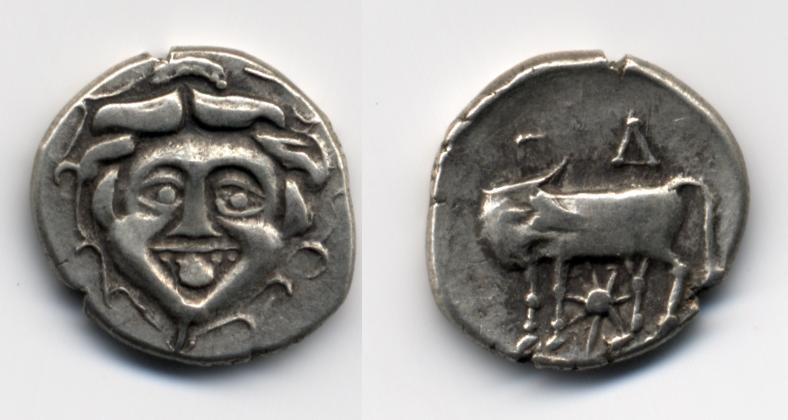
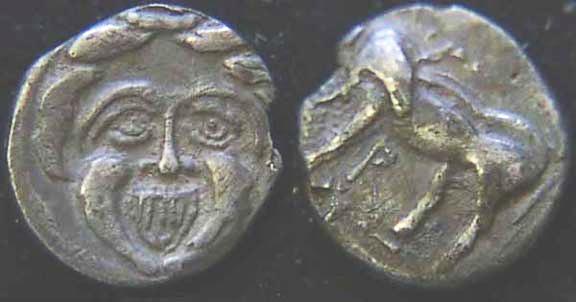
Another example of an imitation of the Parion gorgon / bull hemidrachm can be seen in Numismatik Lanz München auction 109 lot 58. Another foureé can be seen on the Ancient Greek and Roman Coins FAQ Greek fourré page.
Readers are invited to send notices of other foureés and imitations, I'd like to look for die matches.
Sear suggests a value of £85 for this issue. These examples cost $50-90.
The first example is similar in style and type to the hemidrachms. It is much larger (22mm diameter). Examples have been published in SNG France (1402) and SNV von Aulock (1327).
The second example is oval shaped, 18x22mm, weighing 6.97g. The gorgon appears more humanistic and the tongue does not protrude. The reverse (eagle) is obscured by an unrecognized countermark.
Parion also struck an AE13 with owl reverse, and perhaps a smaller bronze with bull reverse, although on that coin the facing head is described as 'Athena'. The eagle type is scarce and the others rare.
Cast fakes of archaic Parion silver units have been identified.
The www.ancients.info gallery is reporting several counterfeit parion hemidrachms. [Example 1] [Example 2]
Thanks to the following dealers for selling these coins: Ancient Auction House, Antiquity Bureau, Mediterranean Coins, Barry and Darling, WCNC, Classical Cash, Herakles Numismatics, Alex G. Malloy, Colosseum Coin Exchange, and Ed Waddell
For more information on the Gorgon in Greek art and myth I recommend the book Medusa: Solving the Mystery of the Gorgon by Stephen R. Wilk.
For more example coins see the Parion thumbnail page at WildWinds.com
Also see the Historia Numorum entry for Parium.
Numismatic references:
Greek coins and their values. Vol. II. Asia and North Africa by David Sear. 1979.
The Arthur S. Dewing collection of Greek coins, edited by Leo Mildenberg and Silvia Hurter. 1985.
Catalogue of Greek Coins in the Hunterian Collection, University of Glasgow, George McDonald. 1899-1905.
Wheaton College Collection of Greek and Roman Coins; J. David Bishop, R. Ross Holloway. 1981.
Sylloge Nummorum Graecorum, Deutschland, Sammlung der Universitätsbibliothek Leipzig. 1993.
Keltische Numismatik 2 Robert Forrer.